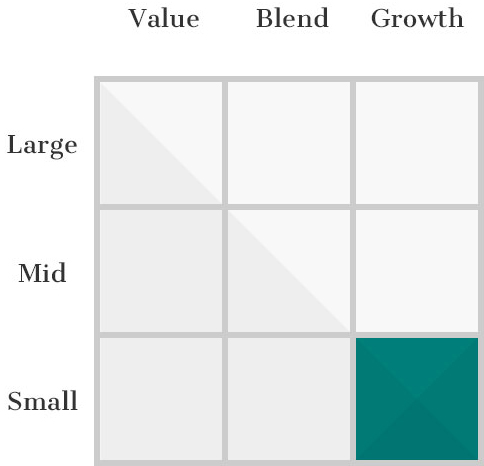Early Stage Growth Fund
Quick Facts
| Investor | Institutional | |
| Ticker: | BUFOX | BUIOX |
| Daily Pricing: | ||
| As of 10/21/2024 | ||
| NAV: | $16.88 | $17.02 |
| $ Change: | $-0.24 | $-0.23 |
| % Change: |
-1.40% | -1.33% |
| YTD: |
9.47% | 9.52% |
| Inception Date: | 5/21/2004 | 7/1/2019 |
| Expense Ratio: | 1.50% | 1.35% |
| Total Net Assets: | $73.85 Million (9/30/24) | |
| Morningstar Category: | Small Cap Growth | |
| Benchmark Index: | Russell 2000 Growth | |
|
Related Material: Fund Fact Sheet Q3 2024 PM Commentary Q2 2024 |
||
Fund Objective & Investment Process
The investment objective of the Buffalo Early Stage Growth Fund is long-term growth of capital. The Fund invests primarily in equity securities, consisting of common stocks, preferred stocks, convertible securities, warrants and rights, of companies that, at the time of purchase by the Fund, are defined as early stage growth companies. Early stage growth companies are defined by the Fund as companies, at the time of purchase, with market capitalizations below the weighted average of the Russell 2000 Growth Index and are starting to develop a new product or service or have recently developed a new product or service.
The Fund managers seek to identify companies for the Fund’s portfolio that are expected to experience growth based on the identification of long-term, measurable secular trends, and which, as a result, may have potential revenue growth in excess of the gross domestic product growth rate. Companies are screened using in-depth, in-house research to identify premier early-stage growth companies which generally demonstrate:
- Strong management teams
- Little or no debt
- Potential for increasing free cash flow
- Scalable business models with a competitive advantage
- Potential for increasing margins
- Attractive risk/reward given the market framework
We believe investing in an actively-managed portfolio of premier, early-stage, growth companies could lead to growth of capital over time. We look for companies that could benefit from long-term industrial, technological, or general market trends, and are trading at what we view as attractive valuations.
Craig Richard, Portfolio Manager
Morningstar Rating





Overall Morningstar Rating™ of BUFOX based on risk-adjusted returns among 545 Small Growth funds as of 9/30/24.
Investment Style

Performance (%)
| As of 9/30/24 | 3 MO | YTD | 1 YR | 3 YR | 5 YR | 10 YR | 15 YR | Since Inception |
|---|---|---|---|---|---|---|---|---|
| BUFFALO EARLY STAGE GROWTH FUND - Investor | 7.99 | 9.60 | 20.28 | -6.75 | 8.36 | 9.17 | 12.26 | 8.43 |
| BUFFALO EARLY STAGE GROWTH FUND - Institutional | 7.99 | 9.59 | 20.27 | -6.65 | 8.49 | 9.32 | 12.42 | 8.58 |
| Russell 2000 Growth Index | 8.41 | 13.22 | 27.66 | -0.35 | 8.82 | 8.95 | 11.09 | 8.88 |
| As of 9/30/24 | 3 MO | YTD | 1 YR | 3 YR | 5 YR | 10 YR | 15 YR | Since Inception |
|---|---|---|---|---|---|---|---|---|
| BUFFALO EARLY STAGE GROWTH FUND - Investor | 7.99 | 9.60 | 20.28 | -6.75 | 8.36 | 9.17 | 12.26 | 8.43 |
| BUFFALO EARLY STAGE GROWTH FUND - Institutional | 7.99 | 9.59 | 20.27 | -6.65 | 8.49 | 9.32 | 12.42 | 8.58 |
| Russell 2000 Growth Index | 8.41 | 13.22 | 27.66 | -0.35 | 8.82 | 8.95 | 11.09 | 8.88 |
| 2013 | 2014 | 2015 | 2016 | 2017 | 2018 | 2019 | 2020 | 2021 | 2022 | 2023 | |
|---|---|---|---|---|---|---|---|---|---|---|---|
| BUFFALO EARLY STAGE GROWTH FUND - Investor | 61.70 | -7.38 | -9.41 | 11.05 | 27.18 | -3.95 | 34.03 | 47.69 | 7.79 | -30.76 | 9.83 |
| BUFFALO EARLY STAGE GROWTH FUND - Institutional | 61.94 | -7.24 | -9.28 | 11.22 | 27.37 | -3.81 | 34.20 | 47.96 | 7.94 | -30.66 | 9.98 |
| Russell 2000 Growth Index | 43.30 | 5.60 | -1.38 | 11.32 | 22.17 | -9.31 | 28.48 | 34.63 | 2.83 | -26.36 | 18.66 |
3 Year Risk Metrics
| BUFOX vs Russell 2000 Growth Index (As of 9/30/24) | |
|---|---|
| Upside Capture | 82.42 |
| Downside Capture | 105.14 |
| Alpha | -6.45 |
| Beta | 0.95 |
| Sharpe Ratio | -0.47 |
Hypothetical Growth of $10,000
This chart illustrates the performance of a hypothetical $10,000 investment made in the Fund on the Inception Date. Assumes reinvestment of dividends and capital gains. This chart does not imply future performance.
Portfolio
Portfolio Characteristics
| (As of 9/30/24) | |
|---|---|
| # of Holdings | 56 |
| Median Market Cap | $1.63 B |
| Weighted Average Market Cap | $3.49 B |
| 3-Yr Annualized Turnover Ratio | 18.39% |
| % of Holdings with Free Cash Flow | 76.79% |
| Active Share | 94.56% |
Top 10 Holdings
| Holding | Ticker | Sector | % of Net Assets |
|---|---|---|---|
| Hamilton Lane, Inc. | HLNE | Financials | 3.34 |
| Willdan Group, Inc. | WLDN | Industrials | 3.17 |
| Verra Mobility Corp. | VRRM | Industrials | 3.03 |
| Compass Diversified Holdings | CODI | Financials | 2.92 |
| Transcat, Inc. | TRNS | Information Technology | 2.77 |
| CyberArk Software, Ltd. | CYBR | Information Technology | 2.69 |
| Bowman Consulting Group, Ltd. | BWMN | Industrials | 2.66 |
| HealthStream, Inc. | HSTM | Health Care | 2.59 |
| OneSpaWorld Holdings, Ltd. | OSW | Industrials | 2.56 |
| Apogee Enterprises, Inc. | APOG | Industrials | 2.56 |
| TOP 10 HOLDINGS TOTAL | 28.29% | ||
Sector Weighting
As of 9/30/24. Security weightings are subject to change and are not recommendations to buy or sell any securities. Sector Allocation may not equal 100% due to rounding.
Market Capitalization
As of 9/30/24. Market Cap percentages may not equal 100% due to rounding.
Management
Commentary
The opinions expressed are those of the Portfolio Manager(s) and are subject to change, are not guaranteed and should not be considered recommendations to buy or sell any security. Earnings growth is not representative of the fund’s future performance.
Literature
| Buffalo Early Stage Growth Documents | Last Updated |
|---|---|
| Fact Sheet | 9/30/24 |
| Quarterly Commentary | 6/30/24 |
| Full Fund Holdings | 6/30/24 |
| Prospectus | 7/29/24 |
| Statement of Additional Information | 7/29/24 |
| Annual Report | 3/31/24 |
| Semi-Annual Report | 9/30/23 |
| Tax Guide - 2023 | 1/8/24 |
Fundamental Approach
We get to know the companies we invest in and learn how they run their business.
Top-Down & Bottom-Up
We identify Top-Down broad, secular growth trends and search for companies from the Bottom-Up.
Proprietary Philosophy
We construct our portfolios based on our own proprietary investment strategy.
Disciplined Investing
Sticking to our disciplined investment strategy ensures we maintain a consistent, balanced approach.
The Morningstar Rating™ for funds, or "star rating", is calculated for managed products (including mutual funds, variable annuity and variable life subaccounts, exchange-traded funds, closed-end funds, and separate accounts) with at least a three-year history. Exchange-traded funds and open-ended mutual funds are considered a single population for comparative purposes. It is calculated based on a Morningstar Risk-Adjusted Return measure that accounts for variation in a managed product's monthly excess performance, placing more emphasis on downward variations and rewarding consistent performance. The top 10% of products in each product category receive 5 stars, the next 22.5% receive 4 stars, the next 35% receive 3 stars, the next 22.5% receive 2 stars, and the bottom 10% receive 1 star. The Overall Morningstar Rating™ for a managed product is derived from a weighted average of the performance figures associated with its three-, five-, and 10-year (if applicable) Morningstar Rating™ metrics. The weights are: 100% three-year rating for 36-59 months of total returns, 60% five-year rating/40% three-year rating for 60-119 months of total returns, and 50% 10-year rating/30% five-year rating/20% three-year rating for 120 or more months of total returns. While the 10-year overall star rating formula seems to give the most weight to the 10-year period, the most recent three-year period actually has the greatest impact because it is included in all three rating periods.
The Buffalo Early Stage Growth Fund (BUFOX) received 2 stars among 545 for the three-year, 2 stars among 517 for the five-year, and 2 stars among 398 Small Growth funds for the ten-year period ending 9/30/24.


